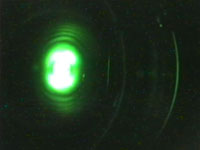FEL Applications - Carbon Nanotube
Carbon nanotube synthesis by NASA and Jefferson Lab moves from research to production phase
What began in 2001 as an academic investigation of how to make carbon nanotubes with a free-electron laser (FEL) has moved into a new phase. Researchers at NASA’s Langley Research Center, Hampton, Va., and the FEL at the Department of Energy’s Thomas Jefferson National Accelerator Facility are now producing high-quality, single-wall carbon nanotubes in quantities sufficient for testing in aerospace applications.
Carbon nanotubes generally measure about one nanometer, one billionth of a meter, wide and have stretched to up to one millimeter long. A cousin of the buckyball, a single carbon nanotube is essentially a sheet of graphite curled up into a cylinder. Nanotubes were discovered in 1991, and it’s thought that they may lead to an entirely new generation of materials as strong or stronger than steel, but very lightweight.
Laser-synthesized nanotubes tend to have superior properties to those produced by other techniques. The raw material can be very pure, and the tubes themselves are straight, homogeneous, and defect-free. The problem is making them in large quantities. Typical tabletop lasers use tens of watts to make nanotubes at around 200 milligrams per hour.
Michael W. Smith, a staff scientist at NASA Langley Research Center, and his colleagues designed a new nanotube synthesis process and apparatus that uses a custom-made, rod-shaped graphite target. A beam of infrared laser light at a wavelength of 1.6 microns from the Jefferson Lab FEL vaporizes layers of the spinning target to create a plume of nanotubes. The process has so far proven it can make about 100 milligrams per minute; that rate can fill a coffee cup with raw material in about 15 minutes. The researchers are increasing the yield as research continues.
The Jefferson Lab FEL's unique laser beam makes nanotubes differently than a conventional laser. It emits a series of "ultrafast" infrared laser light pulses (each pulse lasts less than a picosecond, or one trillionth of a second) at a high repetition rate of 9.4 MHz, about 9.4 million flashes a second. The ultrafast pulses from the Jefferson Lab FEL directly excite the reactants to form the nanotubes, unlike a conventional laser, which heats up a material to produce them. Research continues into how the FEL production process differs from traditional laser synthesis and how it has facilitated scale-up.
Currently, the scientists are varying the laser's parameters – including the pulse structure, wavelength, power, and spot size – to determine what characteristics produce the best carbon nanotubes at the fastest rate. One interesting finding so far is that the diameter of the nanotubes can be varied by changing the laser’s parameters. Since different applications require different sizes, this may turn out to be a big advantage of FEL-synthesized nanotubes.
Initial applications of the nanotubes at NASA Langley will be in fiber-reinforced materials. The research is now focusing on purifying and processing the raw material and will soon shift to incorporating nanotubes into palm-sized test pieces. NASA is interested in high-strength, lightweight materials that are multifunctional (can sense strain, bend and flex themselves, or conduct heat and electric charge). In theory, carbon nanotube-reinforced materials can do all of these, saving critical weight in a myriad of aero and space applications.
NASA Langley and DOE Jefferson Lab FEL scientists expect a major announcement in the next few months. Institutions affiliated with the research include NASA Langley Research Center, Thomas Jefferson National Accelerator Facility (Jefferson Lab), National Institute of Aerospace (NIA), The College of William & Mary Department of Applied Science and Luna Innovations, Inc.
Contacts:
Kandice Carter
Jefferson Lab
kcarter@jlab.org
301-467-0176 (cell) APS meeting preferred contact
757-269-7263 (office)
Marny Skora
NASA Langley Research Center
757-864-3315 (office)
757-344-6111 (cell)


